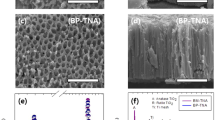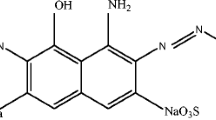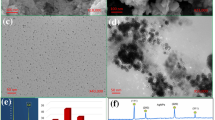Abstract
A green and sustainable approach to azo dye degradation by an electrochemically active biofilm (EAB) with Au@TiO2 nanocomposite assistance (average size of Au ~8 nm) has been developed with high efficiency and mineralization of toxic intermediates. The EAB-Au@TiO2 system degraded the dye more rapidly than the EAB without the nanocomposite, which indicated the catalytic role of the Au@TiO2 nanocomposite on the dye degradation. Toxicity measurements showed that the dye wastewater treated by the EAB-Au@TiO2 system was almost non-toxic while the dye wastewater treated by the EAB without the nanocomposite showed a high toxicity compared to the parent dye. Quantized charging and Fermi level equilibration within the Au@TiO2 nanocomposite may be attributed to the excellent catalytic activity of the nanocomposite on the dye degradation. A mechanism of the catalytic activity is also proposed. Redox behavior and quantized charging of the nanocomposite were confirmed by cyclic voltammetry (CV) and differential pulse voltammetry (DPV), respectively. The proposed protocol can be effectively utilized in wastewater treatment applications.




Similar content being viewed by others
References
Anjaneyulu Y, Sreedhara Chary N, Raj SSD (2005) Decolorization of industrial effluents-available methods and emerging technologies—A review. Rev Environ Sci Biotechnol 4:245
Borole AP, Reguera G, Ringeisen B, Wang Z-W, Feng Y, Kim BH (2011) Electroactive biofilms: current status and future research needs. Energy Environ Sci 4:4813–4834
Chang JS, Chen BY, Lin YS (2004) Stimulation of bacterial decolorization of an azo dye by extracellular metabolites from Escherichia coli strain NO3. Bioresource Technol 91:243
Chen S, Ingram RS, Hostetler MJ, Pietron JJ, Murray RW, Schaaff TG, Khoury JT, Alvarez MM, Whetten RL (1998) Gold nanoelectrodes of varied size: transition to molecule-like charging. Science 280:2098–2101
Choi H, Chen WT, Kamat PV (2012) Know thy nano neighbor. Plasmonic versus electron charging effects of metal nanoparticles in dye-sensitized solar cells. ACS Nano 6:4418–4427
Dawson A, Kamat PV (2001) Semiconductor-metal nanocomposites. Photoinduced fusion and photocatalysis of gold capped TiO2 (TiO2/gold) nanoparticles. J Phys Chem B 105:960–966
Erable B, Duteanu NM, Ghangrekar MM, Dumas C, Scott K (2010) Applications of electro- active biofilms. Biofouling 26:57–71
Gupta N, Singh HP, Sharma RK (2011) Metal nanoparticles with high catalytic activity in degradation of methyl orange: an electron relay effect. J Molecular Catalysis A: Chemical 335:248–252
Harris C, Kamat PV (2010) Photocatalytic events of CdSe quantum dots in confined media. Electrodic behavior of coupled platinum nanoparticles. ACS Nano 4:7321–7330
Hoffmann MR, Martin ST, Choi W, Bahnemann DW (1995) Environmental applications of semiconductor Photoctalaysis. Chem Rev 95:69–96
Husain Q (2010) Peroxidase mediated decolorization and remediation of wastewater containing industrial dyes: a review. Rev Environ Sci Biotechnol 9:117–140
Kalathil S, Lee J, Cho MH (2011a) Granular activated carbon based microbial fuel cell for simultaneous decolorization of real dye wastewater and electricity generation. New Biotechnol 29:32–37
Kalathil S, Lee J, Cho MH (2011b) Electrochemically active biofilm-mediated synthesis of silver nanoparticles in water. Green Chem 13:1482–1485
Kalathil S, Lee J, Cho MH (2012a) Efficient decolorization of real dye wastewater and bioelectricity generation using a novel single chamber biocathode-microbial fuel cell. Bioresource Technol 119:22–27
Kalathil S, Khan MM, Banerjee AN, Lee J, Cho MH (2012b) A simple biogenic route to rapid synthesis of Au@TiO2 nanocomposites by electrochemically active biofilms. J Nanopart Res 14:1051
Kamat PV (2007) Meeting the clean energy demand: nanostructure architectures for solar energy conversion. J Phys Chem C 111:2834–2860
Lin J, Zhang X, Li Z, Lei L (2010) Biodegradation of reactive blue 13 in a two stage anaerobic/aerobic fluidized beds system with a Pseudomonas sp Isolate. Bioresource Technol 101:34
Liu L, F-b Li, C-h Feng, X-z Li (2009) Microbial fuel cell with an azo-dye feeding cathode. Appl Microbiol Biotechnol 85:175–183
Lovrić M, Scholz F (2003) Modeling cyclic voltammograms of simultaneous electron and ion transfer at a conic film three-phase electrode. J Electroanalytical Chem 540:89–96
Morawski BS, Quan S, Arnold FH (2000) Functional expression and stabilization of horseradish peroxidase by directed evolution in Saccharomyces cerevisiae. Biotechnol Bioeng 76:99
Murray RW (2008) Nanoelectrochemistry: metal nanoparticles, nanoelectrodes and nanopores. Chem Rev 108:2688–2720
Oldfield G, Ung T, Mulvaney P (2000) Au@SnO2 core-shell nanocapacitors. Adv Mater 12:1519–1522
Pant D, Bogaert GV, Diels L, Vanbroekhoven K (2010) A review of substrates used in microbial fuel cells (MFCs) for sustainable energy production. Bioresource Technol 101:1533–1543
Primo A, Corma A, García H (2011) Titania supported gold nanoparticles as photocatalyst. Phys Chem Chem Phys 13:886–910
Robinson T, McMullan G, Marchant R, Nigam P (2001) Remediation of dyes in textiles effluent: a critical review on current treatment technologies with a proposed alternative. Bioresour Technol 77:247–255
Saratale RG, Saratale GD, Chang JS, Govindwar SP (2011) Bacterial decolorization and degradation of azo dyes: a review. J Taiwan Institute of Chemical Engineers 42:138–157
Takai A, Kamat PV (2011) Capture, store, and discharge. Shuttling photogenerated electrons across TiO2-silver interface. ACS Nano 5:7369–7376
Tsunoyama H, Ichikuni N, Sakurai H, Tsukuda T (2009) Effect of electronic structures of Au clusters stabilized by poly(N-vinyl-2-pyrrolidone) on aerobic oxidation catalysis. J Am Chem Soc 131:7086–7093
Vandevivere PC, Bianchi R, Verstraete W (1998) Treatment and reuse of wastewater from the textile wet-processing industry: review of emerging technologies. J Chem Technol Biotechnol 72:289
Wang H, Zheng SW, Su JQ, Tian Y, Xiong XJ, Zheng TL (2009) Biological decolorization of the reactive dyes reactive black 5 by a novel isolated bacterial strain Enterobacter sp. EC3. J Hazard Mater 171:654
Acknowledgments
This research was supported by Basic Science Research Program through the National Research Foundation of Korea (NRF) funded by the Ministry of Education, Science and Technology (Grant No: 2012R1A1A4A01005951). Shafeer Kalathil was supported by the Human Resources Development Program of Korea Institute of Energy Technology Evaluation and Planning (KETEP) Grant (No:20104010100580) funded by the Korean Ministry of Knowledge Economy.
Author information
Authors and Affiliations
Corresponding author
Electronic supplementary material
Below is the link to the electronic supplementary material.
Rights and permissions
About this article
Cite this article
Kalathil, S., Lee, J. & Cho, M.H. Catalytic role of Au@TiO2 nanocomposite on enhanced degradation of an azo-dye by electrochemically active biofilms: a quantized charging effect. J Nanopart Res 15, 1392 (2013). https://doi.org/10.1007/s11051-012-1392-5
Received:
Accepted:
Published:
DOI: https://doi.org/10.1007/s11051-012-1392-5




